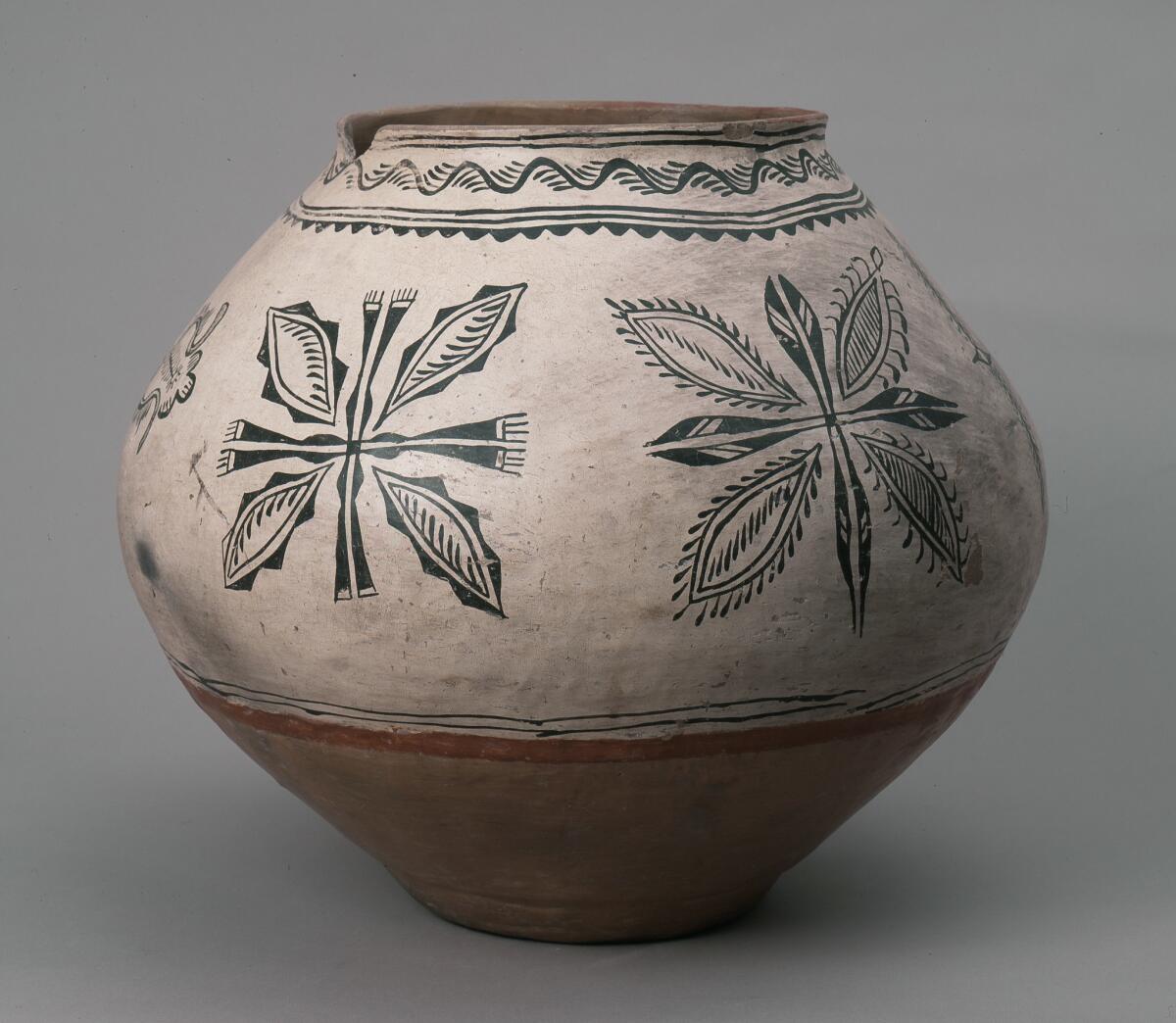Pottery collection casts an eye on continuity

The modern art of the 20th Century didn’t arrive fully formed without antecedents. In the case of the Art Deco movement of the 1920s, the style drew on the geometry, sleekness and minimalism of classicism. While Deco may have had a primary stronghold in Germany’s Bauhaus, its gospel spread far and wide, adapting to local customs and usage.
In Southern California, we sometimes take for granted the design elements that reflect the Southwest in our Deco. Whether it’s a Hermosa Beach house that nicks the Mission style, Indian visages on the Mayan Theatre exterior, cornstalks in an ornamental frieze on Long Beach’s Lafayette Hotel, the wavy lines of the Argyle Hotel in West Hollywood, or the Wiltern’s diagonal gingerbread — modernist architects and designers have reinforced the connection between Indians and the city of Los Angeles.
The symbiosis of the so-called “primitive” and the modern is just one of the features of the new permanent installation of Native American pottery at the Mt. Washington campus of the Southwest Museum. With the Autry National Center, the museum has assembled an impressive array of jars, bowls, pots and other objects, encompassing 400 years of Native American clay vessels. Culled from six tribes and 30 villages in Arizona and New Mexico including the Hopi and Zuni, “Four Centuries of Pueblo Pottery” gives a good accounting of Indian clay-making tradition, both prior to the Spanish conquest and after.
These are utilitarian objects for everyday usage, and the human hand is seen in all of them. Kim Walters, the Autry’s Ahmanson Curator of Native American History and Culture, has gathered more than 100 historic pieces from the Southwest Museum. She sees a consistency of craft in the grouping.
“Most of the symmetrical vessels were made by coiling strands of clay together,” she pointed out, “rather than with a potter’s wheel; that came after they had contact with tourists and realized that there was an outside market for these vessels.”
The Santa Fe Trail, and later the Santa Fe Superchief, brought the outside world to the pueblos. “They sold their pieces in train stations,” said Walters. “Certainly, the pueblo artisans were not immune to the various periods and styles of European art, and the Deco motifs were probably a response to the tourist trade. And maybe the trader at the pueblo looked at what was selling and influenced designs.”
“They didn’t use ovens to bake the clay,” Walters said. “They dug a pit and fired it with animal dung. It was hard to control but the accomplished potters knew how to sustain the heat evenly for long periods. Even today, some of the craftspeople who make these vessels use the traditional methods.”
It’s instructive to view clay jars and bowls with decorative designs (probably painted with horsehair or animal sinew) of corn, ziggurats, geometric Katsina faces, curving snakes and plant forms that would later surface in the Art Deco of Los Angeles and elsewhere in the western states. Independent of that style, there are some graceful black vessels from different sources that would look right at home in the still-life photographs of Edward Steiglitz or Paul Strand.
Likewise, a pot with a tapered, fluted neck has an unintended connection to Greek columns. It brings to mind Duke Ellington’s timeless question: Just who is basking in the shadow of whom? Be careful what you call “primitive.”
“You can see that there’s a lot of variety in this collection,” Walters added. “But there’s also a fair amount of continuity — from the precontact era to today. Some of the designs have been carried through the generations within one family or another. We can also see that in the hands of the various artisans, a craft was turned into a true art form.”
What: “Four Centuries of Pueblo Pottery”
Where: Sprague Auditorium, Southwest Museum, Mt. Washington Campus, 234 Museum Drive, Los Angeles
When: Saturdays only
More info: (323) 667-2000
--
KIRK SILSBEE writes about jazz and culture for Marquee.